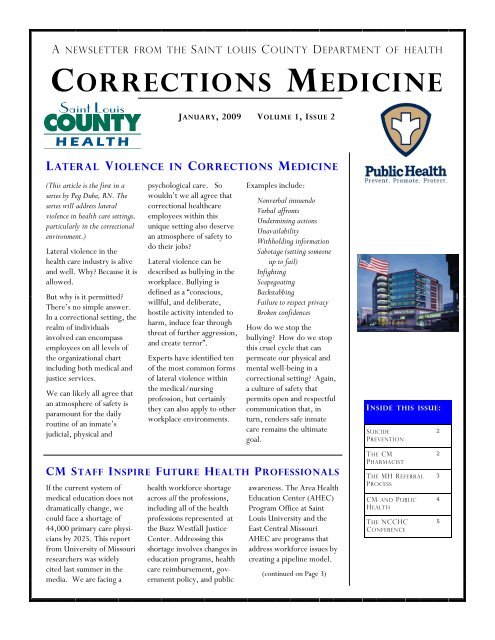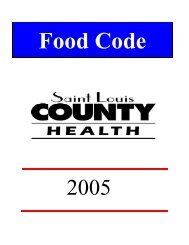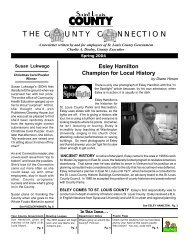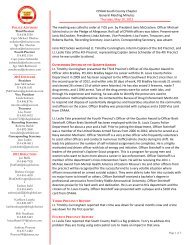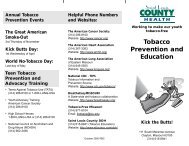CORRECTIONS MEDICINE - St. Louis County
CORRECTIONS MEDICINE - St. Louis County
CORRECTIONS MEDICINE - St. Louis County
Create successful ePaper yourself
Turn your PDF publications into a flip-book with our unique Google optimized e-Paper software.
A NEWSLETTER FROM THE SAINT LOUIS COUNTY DEPARTMENT OF HEALTH<br />
<strong>CORRECTIONS</strong> <strong>MEDICINE</strong><br />
JANUARY, 2009 VOLUME 1, ISSUE 2<br />
LATERAL VIOLENCE IN <strong>CORRECTIONS</strong> <strong>MEDICINE</strong><br />
(This article is the first in a<br />
series by Peg Dube, RN. The<br />
series will address lateral<br />
violence in health care settings,<br />
particularly in the correctional<br />
environment.)<br />
Lateral violence in the<br />
health care industry is alive<br />
and well. Why? Because it is<br />
allowed.<br />
But why is it permitted?<br />
There’s no simple answer.<br />
In a correctional setting, the<br />
realm of individuals<br />
involved can encompass<br />
employees on all levels of<br />
the organizational chart<br />
including both medical and<br />
justice services.<br />
We can likely all agree that<br />
an atmosphere of safety is<br />
paramount for the daily<br />
routine of an inmate’s<br />
judicial, physical and<br />
psychological care. So<br />
wouldn’t we all agree that<br />
correctional healthcare<br />
employees within this<br />
unique setting also deserve<br />
an atmosphere of safety to<br />
do their jobs?<br />
Lateral violence can be<br />
described as bullying in the<br />
workplace. Bullying is<br />
defined as a “conscious,<br />
willful, and deliberate,<br />
hostile activity intended to<br />
harm, induce fear through<br />
threat of further aggression,<br />
and create terror”.<br />
Experts have identified ten<br />
of the most common forms<br />
of lateral violence within<br />
the medical/nursing<br />
profession, but certainly<br />
they can also apply to other<br />
workplace environments.<br />
Examples include:<br />
Nonverbal innuendo<br />
Verbal affronts<br />
Undermining actions<br />
Unavailability<br />
Withholding information<br />
Sabotage (setting someone<br />
d up to fail)<br />
Infighting<br />
Scapegoating<br />
Backstabbing<br />
Failure to respect privacy<br />
Broken confidences<br />
How do we stop the<br />
bullying? How do we stop<br />
this cruel cycle that can<br />
permeate our physical and<br />
mental well-being in a<br />
correctional setting? Again,<br />
a culture of safety that<br />
permits open and respectful<br />
communication that, in<br />
turn, renders safe inmate<br />
care remains the ultimate<br />
goal.<br />
CM STAFF INSPIRE FUTURE HEALTH PROFESSIONALS<br />
If the current system of<br />
medical education does not<br />
dramatically change, we<br />
could face a shortage of<br />
44,000 primary care physicians<br />
by 2025. This report<br />
from University of Missouri<br />
researchers was widely<br />
cited last summer in the<br />
media. We are facing a<br />
health workforce shortage<br />
across all the professions,<br />
including all of the health<br />
professions represented at<br />
the Buzz Westfall Justice<br />
Center. Addressing this<br />
shortage involves changes in<br />
education programs, health<br />
care reimbursement, government<br />
policy, and public<br />
awareness. The Area Health<br />
Education Center (AHEC)<br />
Program Office at Saint<br />
<strong>Louis</strong> University and the<br />
East Central Missouri<br />
AHEC are programs that<br />
address workforce issues by<br />
creating a pipeline model.<br />
(continued on Page 3)<br />
INSIDE THIS ISSUE:<br />
SUICIDE<br />
PREVENTION<br />
THE CM<br />
PHARMACIST<br />
THE MH REFERRAL<br />
PROCESS<br />
CM AND PUBLIC<br />
HEALTH<br />
THE NCCHC<br />
CONFERENCE<br />
2<br />
2<br />
3<br />
4<br />
5
PAGE 2<br />
<strong>CORRECTIONS</strong> <strong>MEDICINE</strong><br />
SUICIDE PREVENTION IN <strong>CORRECTIONS</strong><br />
On August 22nd, 2008, a group of<br />
Corrections Medicine Management<br />
Team members and Mental Health<br />
providers met at the Double Tree<br />
Conference Center in Chesterfield to<br />
attend the Suicide in Jails and Prisons<br />
Conference, sponsored by the<br />
University of Missouri Institute of<br />
Mental Health, the University of<br />
Missouri School of Medicine, and the<br />
University of Missouri Sinclair School<br />
of Nursing. The audience comprised<br />
attendees from Missouri, Illinois,<br />
Nebraska, and Kansas corrections<br />
systems ranging in size from jails of<br />
100 beds or less to large prison<br />
systems.<br />
The content of the conference was<br />
well presented and focused on various<br />
aspects of suicide prevention. The<br />
final general session of the morning<br />
was a very interesting and eyeopening<br />
talk by Shanetta Cutlar, Esq.,<br />
from the U.S. Department of Justice,<br />
Civil Rights Division. Ms. Cutlar’s<br />
presentation covered the role of her<br />
division in the investigation of care<br />
provided at state and local facilities.<br />
The afternoon sessions were divided<br />
into various breakout sessions,<br />
covering topics from the challenges of<br />
psychiatric diagnosis in corrections to<br />
risk management strategies.<br />
I attended the breakout session on<br />
Suicide as a Trauma Response in<br />
female offenders. The presentation<br />
focused on the difficulty some females<br />
have in adapting to the corrections<br />
setting. Often the surroundings bring<br />
Post Traumatic <strong>St</strong>ress Disorder<br />
(PTSD) flashback responses and these<br />
women see no other way out than to<br />
attempt suicide.<br />
The other session I attended was Risk<br />
Management <strong>St</strong>rategies. The speaker<br />
for this session built upon the<br />
information presented by Ms. Cutlar<br />
earlier in the day by including actual<br />
case reviews. The speaker for this<br />
session is also having an article on the<br />
same subject published in the January,<br />
2009, issue of the Journal of<br />
Correctional Healthcare.<br />
Overall, the conference was very<br />
informative, providing a wealth of<br />
information that can be used by our<br />
team to establish an effective suicide<br />
prevention training program for the<br />
Corrections Medicine staff.<br />
Contributed by:<br />
Brenda Wessel, RN<br />
Accreditation standards require<br />
all Corrections Medicine staff to<br />
attend a suicide prevention<br />
training session annually.<br />
Recently, sessions were<br />
conducted by Dr. Rod Hoevet on<br />
November 25th and December<br />
9th of last year. <strong>St</strong>ay tuned for<br />
dates, times, and locations of<br />
future sessions.<br />
THE CM PHARMACIST AND HIS EDUCATIONAL PROGRAMS<br />
Philip Wenger, PharmD, joined our program in Corrections Medicine on July 1st, 2007. As Assistant Professor of<br />
Pharmacy Practice at the Saint <strong>Louis</strong> College of Pharmacy, he has developed a new position as Clinical Pharmacist for<br />
Corrections Medicine: Saint <strong>Louis</strong> <strong>County</strong> Department of Health.<br />
His role in the program has evolved over the past year and a half. At the Justice Center he role-models consultative<br />
pharmacy practice to students in their final year of study at the College. These student experiences are five weeks in<br />
duration and allow students to observe and participate in ambulatory care of patients with acute and chronic disease<br />
states. On campus, Dr. Wenger coordinates and teaches the fourth year therapeutics course, advises students<br />
longitudinally during their college experiences, and introduces students to rudimentary clinical assessment techniques.<br />
“Splitting my time between my teaching responsibilities on campus and my clinical responsibilities at the Justice Center<br />
is an ideal combination. I can’t imagine a more challenging combination.”
VOLUME 1, ISSUE 2<br />
PAGE 3<br />
WHAT IS THE MENTAL HEALTH REFERRAL PROCESS?<br />
A nurse can be made aware of an<br />
inmate’s mental health concerns in<br />
several ways. At times, inmates will<br />
simply hand a mental health referral<br />
form to the nurse. At other times, they<br />
may verbally relay a concern. When an<br />
issue is raised verbally, the inmate<br />
should be encouraged to fill out a<br />
mental health referral form. Once the<br />
form has been filled out, the nurse<br />
should deliver that form to the Mental<br />
Health mailbox in the clinic area. This<br />
box is maintained and checked<br />
regularly by our clinical social workers<br />
(Mary Hoatlin, LCSW and Thelma<br />
Hall-Gordon, LCSW). All mental<br />
health referral forms are sorted by the<br />
social workers. Those inmates who<br />
have not already been seen will be<br />
evaluated in order of priority by one of<br />
the social workers. Referrals should<br />
not come directly from nurses to the<br />
mental health providers (i.e. Drs.<br />
Felthous, Hoevet, and Magnoli).<br />
If you have a concern about an inmate,<br />
feel free to send a message or talk to<br />
one of the mental health providers, but<br />
also make sure that a mental health<br />
referral form has been filled out and<br />
submitted using the aforementioned<br />
process. The mental health team uses<br />
this uniform referral process to ensure<br />
that inmates receive the most<br />
appropriate intervention in the quickest<br />
possible time frame. Most inmates’<br />
concerns can be addressed by a social<br />
worker and do not need to be evaluated<br />
by one of the mental health providers.<br />
The providers’ time is best spent<br />
evaluating and treating the most<br />
demanding, complicated, and ailing<br />
inmates.<br />
CONTRIBUTED BY:<br />
ROD HOEVET, PSYD<br />
CM STAFF INSPIRE FUTURE HEALTH PROFESSIONALS<br />
(continued from page 1)<br />
In other words, the programs seek to<br />
recruit adolescents and young adults<br />
into health careers, guide and support<br />
them through their education, place<br />
them in areas that the health care<br />
workforce needs, and support them in<br />
their ongoing practices. Special<br />
emphasis is given to recruiting students<br />
from underserved areas for the purpose<br />
of bringing them back as professionals to<br />
underserved areas to address geographic<br />
health disparities.<br />
East Central Missouri AHEC conducts a<br />
series of Saturday morning programs for<br />
their high school and college students.<br />
The recent 2008-2009 orientation<br />
session in September was conducted at<br />
the Saint <strong>Louis</strong> University School of<br />
Medicine. Fred Rottnek, MD, as the<br />
AHEC Medical Director, called on<br />
Corrections Medicine colleagues to<br />
introduce students to the scope of<br />
practice of some specific health careers.<br />
Joy Barbre, RN, who coordinates the<br />
Juvenile Detention program, spoke<br />
about her practice, her personal story<br />
of how she became a nurse, and the<br />
rewards and challenges in her career.<br />
Rod Hoevet, PsyD, the first<br />
psychologist to ever speak to this<br />
particular AHEC program, explained<br />
what psychologists do, what type of<br />
training they require, and what he<br />
personally enjoys about working at<br />
the Justice Center. Following these<br />
presentations, the three panelists<br />
presented a theoretical (but not<br />
unusual) patient who presented for<br />
diabetic care at a neighborhood health<br />
center; they discussed what priorities<br />
for the patient they would emphasize<br />
from their own professional<br />
perspective.<br />
The students enjoyed the presentation,<br />
the ability to interact with “real-live”<br />
professionals and the chance to observe<br />
how health professionals interact in<br />
meaningful ways. The fact that all of the<br />
panelists choose to work in underserved<br />
care and public health was noted by<br />
students as well. The Corrections<br />
Medicine team demonstrated that<br />
careers that address disparities and<br />
community health needs can be deeply<br />
rewarding and enjoyable.<br />
If you are interested in participating in<br />
future programs with AHEC as a guest<br />
speaker or small group discussion<br />
leader, please contact Dr. Rottnek<br />
about upcoming opportunities. Nothing<br />
speaks more persuasively to these young<br />
adults than stories from the “real”<br />
world.
PAGE 4<br />
<strong>CORRECTIONS</strong> <strong>MEDICINE</strong><br />
Community and Public Health: It’s What We Do<br />
While most of our interactions with<br />
patients in our facility are individual<br />
encounters, many of these<br />
interactions have far-reaching<br />
effects. One such type of interaction<br />
is the Intake Floor Assessment. This<br />
assessment occurs after inmates<br />
enter their housing units or the<br />
infirmary, almost always within 14<br />
days of entering the facility (and<br />
usually much sooner.) Part of this<br />
assessment is screening for<br />
communicable diseases: HIV, RPR,<br />
Urine Gonorrhea and Chlamydia,<br />
and PPD. We are one of the few jails<br />
in the entire country that provides<br />
these screening tests to our inmates.<br />
As such, we received a site visit last<br />
year from the national Centers for<br />
Disease Control and Prevention;<br />
officials wanted to observe how we<br />
manage to provide such extensive<br />
screening in a correctional facility.<br />
The screenings we provide are a<br />
service to both the individual and the<br />
community. By assessing, treating,<br />
and counseling patients with a<br />
sexually transmitted disease or<br />
infectious respiratory illness such as<br />
pulmonary tuberculosis, we also<br />
improve the health of the community<br />
to which the patient returns. As the<br />
funding and number of sites for public<br />
health screenings continue to<br />
decrease in the area, Corrections<br />
Medicine increasingly serves as a true<br />
safety net for health services<br />
necessary for the public health of<br />
the entire community.<br />
The graph below was generated by<br />
the Saint <strong>Louis</strong> <strong>County</strong> Department<br />
of Health’s Communicable<br />
Disease Control Division. It<br />
shows the diagnosed and treated<br />
Chlamydia cases identified among<br />
our inmates since the urine testing<br />
began in 2004. The number of<br />
males indentified and treated<br />
depends on the number of inmates<br />
who enter our facilities, our<br />
staffing patterns in Corrections<br />
Medicine, and the availability of<br />
patients for testing.<br />
(continued on page 5)
VOLUME 1, ISSUE 1<br />
PAGE 5<br />
Community and Public Health: It’s What We Do<br />
(continued from page 4)<br />
The current trend indicates<br />
relatively stable Gonorrhea rates,<br />
but an increase in Chlamydia since<br />
the 3rd quarter of last year. The<br />
current Chlamydia rate is 8.8%.<br />
The DOH CDC is currently<br />
researching trends at other testing<br />
sites in the area in order to evaluate<br />
the significance of this trend and<br />
identify possible interventions.<br />
While this graph represents the<br />
challenging nature of our work (as<br />
well as the volume of our work) in<br />
Corrections Medicine, it also indicates<br />
a reason for us to be proud of our<br />
efforts to improve the health of our<br />
patients and our community.<br />
CM NURSES ATTEND CHICAGO NCCHC CONFERENCE<br />
Highlights of the<br />
NCCHC National Conference<br />
October 18th - 22nd, 2008<br />
Members of the Management Team<br />
and a staff member recently<br />
attended the NCCHC National<br />
Conference. Our train ride Friday<br />
evening was most interesting as it<br />
involved travelling with multiple<br />
college students going out of town<br />
for the weekend. Once arriving<br />
and getting settled into our hotel,<br />
we found the night skyline of<br />
Chicago to be quite awesome.<br />
On Saturday, Brenda Wessel and<br />
Rita Hendrix attended<br />
pre-conference sessions on the<br />
updated standards for jails and a<br />
review of the new Mental Health<br />
<strong>St</strong>andards. As the<br />
Mental Health<br />
<strong>St</strong>andards were<br />
new in 2008,<br />
mostly mental<br />
health care<br />
providers<br />
attended this<br />
class. It was<br />
interesting to<br />
listen to the<br />
presenters as well<br />
as providers and<br />
learn about the<br />
various systems in which they work.<br />
Since this session was geared for jails,<br />
prisons, and juvenile facilities, the<br />
questions were quite varied. Rita<br />
Hendrix attended the updated Jail<br />
<strong>St</strong>andards sessions and had much the<br />
same experience. The<br />
best benefit from these<br />
sessions was the<br />
acquisition of the new<br />
standard books and the<br />
knowledge that our<br />
facility has been<br />
working toward<br />
meeting these<br />
standards for a period<br />
of time.<br />
Our Sunday afternoon session<br />
involved a review of what to do<br />
(and not do) to avoid litigation.<br />
Late Sunday afternoon, Deb Kinder<br />
and Valerie Pfeiffer arrived in the<br />
“Windy City” to attend the main<br />
conference sessions.<br />
As always, some sessions were<br />
livelier than others — just ask<br />
Valerie Pfeiffer. She won some<br />
pink underwear in one of the sessions<br />
she attended! While we could<br />
not possibly attend every session,<br />
we did purchase the entire set of<br />
lectures from the conference to add<br />
to our resource library.<br />
(continued on page 6)
Corrections Medicine<br />
A NEWSLETTER FROM THE SAINT LOUIS<br />
Corrections Medicine:<br />
COUNTY DEPARTMENT OF HEALTH<br />
Saint <strong>Louis</strong> <strong>County</strong> Department of Health<br />
100 South Central Avenue<br />
Clayton, Corrections Missouri Medicine: 63105<br />
Saint <strong>Louis</strong> <strong>County</strong> Department of Health<br />
100 Phone: South 555-555-5555 Central Avenue<br />
Clayton, Fax: 555-555-5555 Missouri 63105<br />
E-mail: someone@example.com<br />
Health Clinic: 314-615-5756<br />
Fax: 314-615-5629<br />
Editor: Fred Rottnek, MD<br />
E-mail: FRottnek@stlouisco.com<br />
W E ’ RE ON THE COUNTY<br />
I NTRANET AT<br />
HTTP://COUNTYNET/<br />
D EPARTMENTS/HEALTH/<br />
H EALTHS ERVICES/<br />
<strong>CORRECTIONS</strong>/ DEFAULT. ASPX<br />
Corrections Medicine is a publication of Corrections Medicine, a<br />
division of the Saint <strong>Louis</strong> <strong>County</strong> Department of Health which<br />
serves the health care needs of people at the Saint <strong>Louis</strong> <strong>County</strong><br />
Justice Center, Juvenile Detention at Family Courts, and the<br />
Lakeside Center.<br />
This publication is a product of the Corrections Medicine Interprofessional<br />
Management Team, whose mission statement follows:<br />
The Interprofessional Team works to meet and surpass standards of care set forth<br />
by the National Commission of Correctional Health Care to optimize patient<br />
health in our facility by:<br />
Creatively and responsibly coordinating and utilizing resources of the Saint<br />
<strong>Louis</strong> <strong>County</strong> Department of Health;<br />
Creating an effective and productive Interprofessional Management Team;<br />
Collaborating with local, state, and national agencies; and,<br />
Bridging patients to aftercare programs for better health outcomes and the<br />
reduction of recidivism.<br />
Inquiries regarding this publication should be directed to the editor, Fred<br />
Rottnek, MD (FRottnek@stlouisco.com), Rita Hendrix, RN, Nurse Manager of<br />
Corrections (RHendrix@stlouisco.com), or Lynne Jones, RN, Health Services<br />
Administrator (LLJones@stlouisco.com).<br />
NCCHC CHICAGO CONFERENCE<br />
What conference would be complete without an exhibit hall? As this was the first major conference for my<br />
colleagues, the exhibit hall was a major “free” shopping arena for them. In addition to all of the “freebies” we<br />
gathered, we did walk away with information on some interesting and innovative products and services.<br />
Chicago being such a fascinating city, our attention was naturally drawn to some of its more popular attractions.<br />
Our feet were VERY tired by the end of each day<br />
because we did a lot of walking, talking, and<br />
window-shopping. Our major excursions involved<br />
the Navy Pier and the Magnificent Mile.<br />
Due to our exhibit hall shopping, we all had at least<br />
one or two extra bags, which made for some<br />
challenging times at the Chicago train station and our<br />
destination stations. Despite that, we arrived home<br />
safe, healthy, and well rested — ready to share our<br />
information and stories.<br />
Of a special note is that even though this was a<br />
national conference, there were attendees from<br />
Canada and New Zealand who joined us in our<br />
educational experience.


